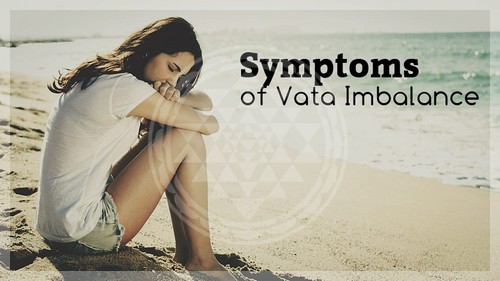The first point to consider here is that we may have Vata dosha as our dominant dosha, or as a secondary one. When we have Vata dosha imbalance, and Vata […] The post Vata Dosha Imbalance Symptoms first appeared...
The first point to consider here is that we may have Vata dosha as our dominant dosha, or as a secondary one.
When we have Vata dosha imbalance, and Vata is our secondary dosha, it means that there will only be some signs or symptoms of the increase of this dosha.
When Vata is your dominant dosha (in our Prakriti), the effect of its imbalance will be felt much stronger.

Vata Characteristics
This dosha is light, dry, rough, cool, mobile and subtle, and these qualities manifest themselves through the body, mind and emotions.
Vata Dosha Imbalance Signs
In the Mind
When there is aggravation of this dosha, one may experience anxiety, fear, nervousness, feeling of insecurity, restlessness, hyperactivity, loneliness or confusion.
When Vata is increased in the mind, one may feel like they cannot calm down, or as if they are jumpy. There can be problems with falling asleep; the sleep itself can be interrupted. If you won’t balance it in the mind, it may lead to mental instability, insomnia, blackouts and severe depression.
Digestion and Elimination
Since the place of residence of Vata dosha is the digestive tract, the first symptoms of Vata imbalance are manifested there in a form of gases, bloating, and constipation; there can also be gurgling intestines, burps and hiccups, and one may feel too much thirsty.
Vata dosha normally has a weak appetite, but when it is increased in the body, the appetite becomes irregular, which often leads to mild weight loss; dryness in the mouth, dry feces, there may be hemorrhoids, diarrhea and pressure under the diaphragm. It is not that all these symptoms will occur simultaneously, but some of them are usually there.
If the aggravation of Vata remains for some extended period of time, one will have problems with elimination, constipation, and one’s stool will become dry and dark, will be small in amount and have a bullet-like shape.
Skin, Hair and Circulation
Excess of Vata dosha is often manifested through the skin dryness, cracking skin, heels and nails, split ends in hair, dandruff. Blood circulation is poor, skin is lusterless and pallor, there can be eczema or psoriasis in severe cases.
Hands and feet are often cold; a person does not sweat enough. The severe cases of Vata imbalance here include brittle hair and nails, nail deformation, skin discoloration, blood clots and varicose veins.
Muscle, Bones, Joints and Nerves
The signs of aggravated Vata in these areas include weakness, muscle fatigue, lack of coordination, tightness and stiffness, joint cracking, muscle pain, tremors, tingling and numbness, sciatica and nerve pain.
If you ignore the imbalance, it may turn into muscle rigidity and atrophy, joint dislocations, rheumatoid arthritis and osteoarthritis, fibromyalgia, spontaneous bone fractures, incontinence, seizures, paralysis, fainting, changes in thyroid function, and even Parkinson’s disease.
Generalized Symptoms of Vata Dosha Imbalance
These will be the ones you can easily identify:
Constipation – digestive tract is the seat of this dosha. Tingling or numbness – Vata is linked to nervous system. Pain (especially low back pain, sciatica). Malabsorption – to see if you have this, just stick out your tongue and look at it before a mirror. If you see teeth indentations along the sides of your tongue, then it can be an indicator of poor absorption of nutrients by your body. Another sign is the vertical ridges on your nail beds. These sings may take place even if your diet is healthy. Malabsorption means that you cannot digest and absorb the nutrients properly and you need to kindle your digestive fire to fix the problem. Insomnia – a sign of restless mind.Common Causes of Vata Imbalance
Eating too rapidly, or not eating enough food; Eating food not very suitable for this dosha: old, dry, raw or cold; Eating at different times; Staying up late; Overexertion; Suppression of bodily urges, such as sneezing, passing gas, or elimination, which is not really good for any dosha and for Vata especially; Overstimulation of the senses; Excessive worry or fear;These are the Vata imbalance symptoms; once you notice them, try to bring your dosha into a balanced state. The first thing to do is to follow a Vata dosha diet.
1. www_banyanbotanicals.com/info/ayurvedic-living/learning-ayurveda/balancing-vata
2. www_banyanbotanicals.com/info/blog-the-banyan-insight/details/signs-symptoms-of-vata-imbalance
3. www_debbyandersen.com/2013/11/5-signs-vata-imbalance
The post Vata Dosha Imbalance Symptoms first appeared on Yoga Yukta.









